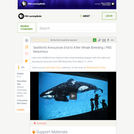
Informational text reading, student handout, and video.
- Subject:
- English Language Arts
- Material Type:
- Reading
- Student Guide
- Provider:
- PBS LearningMedia
- Date Added:
- 03/31/2017

Informational text reading, student handout, and video.
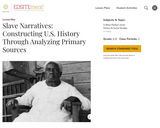
The realities of slavery and Reconstruction hit home in poignant oral histories from the Library of Congress. In these activities, students research narratives from the Federal Writers' Project and describe the lives of former African slaves in the U.S. -- both before and after emancipation. From varied stories, students sample the breadth of individual experiences, make generalizations about the effects of slavery and Reconstruction on African Americans, and evaluate primary source documents.
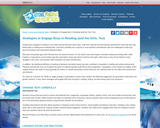
This article provides research-based suggestions for engaging boys in reading and writing.
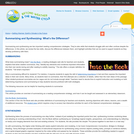
For teachers in K-Grade 5 classrooms, the author of this article reviews the reading comprehension strategies known as Summarizing and Synthesizing. She provides links to web sites and to a book that will provide more background information and lessons. The article appears in the free, online magazine Beyond Weather and the Water Cycle, which focuses on the seven essential principles of climate science.
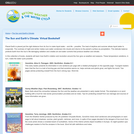
This book list contains children's books that have been screened for accuracy in depicting scientific concepts. Each book's content is briefly described and its cover pictured. The topics of the books support learning in Grades K-5 about the issue's theme. The list appears in the free, online magazine Beyond Weather and the Water Cycle, which focuses on the essential principles of climate literacy.

When designing a text-based lesson, educators must consider many factors that will impact the success of the lesson. One of the most important factors is choosing an appropriate anchor text. An anchor text is the main text that all learning stems from during the lesson or unit.
This module will support educators as they explore questions that help them analyze a proposed text.
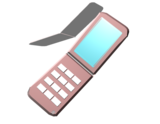
This lesson plan was created by Jani Randall, a sixth grade teacher at Elkhorn Public Schools in Nebraska. The attached Remote Learning Plan is designed for Grade 6 English Language Arts students. Students will read the article and then answer a prompt using text evidence in paragraph form. Students will read the text, and then support claims from the text with their writing. This lesson plan addresses the following NDE Standard: NE 6.1.6IIt is expected that this lesson will take students 60 minutes to complete.
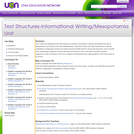
This 18 day unit explicitly teaches text structures, summary, text features, reading informational text about Mesopotamia, and writing a book about Mesopotamia. Instruction moves from high scaffolding to moderate scaffolding to independent practice as students become familiar with the various text structures, how to identify them, what graphic organizer will work with each text structure, how to use notes recorded in graphic organizers to write summaries, and how to compile an informational book. Mesopotamia is the content used as an anchor.
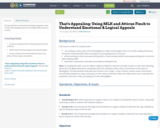
An introduction to emotional and logical appeals, using To Kill a Mockingbird and the Civil Rights Movement as context.
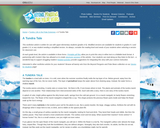
This nonfiction article, written for students in grades 4-5, explores the relationships between various tundra species: marsh marigolds, bot flies, and caribou. Modified versions are available for students in younger grades.
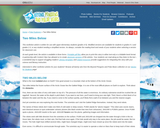
This article describes robots that are helping scientists explore the Gakkel Ridge deep below the Arctic Ocean and links to informational text about them. Versions are available for students in grades K-1, 2-3 and 4-5. Related science and literacy activities are included.
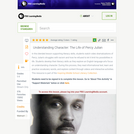
In this blended lesson supporting literacy skills, students watch video dramatizations of Percy Julian's struggles with racism and how he refused to let it limit his possibilities in life. Students develop their literacy skills as they explore an English language arts focus on understanding character. During this process, they read informational text, learn and practice vocabulary words, and explore content through videos and interactive activities. This resource is part of the Inspiring Middle School Literacy Collection.
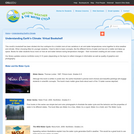
This list of children's books recommends nonfiction titles that supplement basic information found in lessons and activities of this themed issue of the online magazine Beyond Weather and the Water Cycle. The books are grouped by topic -- water, weather and climate, and atmosphere. Each book is described by its content, reading level, and possible uses in the classroom. Covers are pictured. The online magazine is produced for elementary school teachers and is structured around the essential principles of climate sciences and climate literacy.

In this article, teachers find two unit plans (grades K-2 and 3-5) that use resources featured in the science and literacy articles in the magazine. The unit plans are modeled after the five key steps in the learning cycle: engage, explore, explain, expand, and assess, or evaluate. The plans are aligned with the science content standards of the National Science Education Standards and the English language arts standards of the National Council of Teachers of English and the International Reading Association. The plans appear in the free, online magazine Beyond Weather and the Water Cycle.
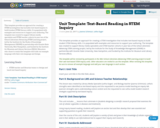
This template provides an approach for creating a STEM investigation that includes text-based inquiry to build student STEM literacy skills. It is populated with examples and resources to support your authoring. The template was created to support library media specialists and STEM teacher cohorts in year two of the School Librarians Advancing STEM Learning project, led by the Institute for the Study of Knowledge Management (ISKME) in partnership with Granite State University, New Hampshire, and funded by the Institute for Museum and Library Services (IMLS). Educators who chose to remix this template will trade out example language with their own language and design.
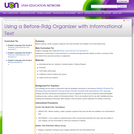
In this lesson students will create a graphic organizer that uses the titles and subtitles of an informational text before they begin reading.
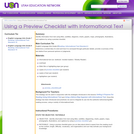
In this lessons students identify information from text using titles, subtitles, diagrams, charts, graphs, maps, photographs, illustrations, and captions by using a preview checklist.
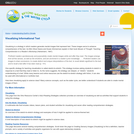
Visualizing is a reading comprehension strategy that can be applied to science-themed texts, according to this article from Beyond Weather and the Water Cycle, a magazine that integrates literacy and science skills instruction. The author identifies six online resources that have activities, lesson plans, and more information.
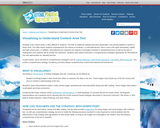
This article discusses the reading comprehension strategy of visualization and how it can be used to enhance students' understanding of content-area text. Templates and links are provided.

The 11 books selected for inclusion in the issue of Beyond Weather and the Water Cycle devoted to climate studies range from easy readers to biographies. Each book is briefly described; all were reviewed for accuracy and appropriate reading levels for students in grades K-5. Several books deal with careers in meteorology.